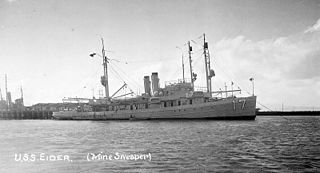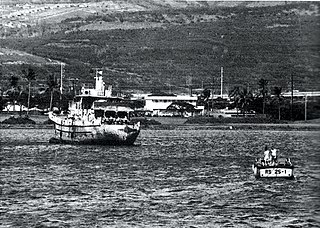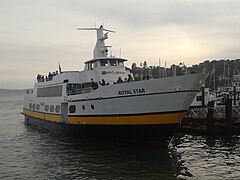Related Research Articles

Tiburon is an incorporated town in Marin County, California. It is located on the Tiburon Peninsula, which reaches south into the San Francisco Bay. The smaller city of Belvedere occupies the south-west part of the peninsula and is contiguous with Tiburon. Tiburon is bordered by Corte Madera to the north and Mill Valley to the west, but is otherwise mostly surrounded by the Bay. Besides Belvedere and Tiburon, much of the peninsula is unincorporated, including portions of the north side and the communities of Strawberry and Paradise Cay.

Angel Island is an island in San Francisco Bay. Originally the home of a military installation, the island now offers picturesque views of the San Francisco skyline, the Marin County Headlands and Mount Tamalpais. The entire island is included within Angel Island State Park, administered by California State Parks. The island, a California Historical Landmark, has been used for a variety of purposes, including military forts, a US Public Health Service Quarantine Station, and a US Bureau of Immigration inspection and detention facility. The Angel Island Immigration Station on the northeast corner of the island, where officials detained, inspected, and examined approximately one million immigrants, has been designated a National Historic Landmark.
Ben Sainsbury is a Canadian filmmaker, actor, and freelance journalist.

Tiburón Island is the largest island in the Gulf of California and the largest island in Mexico, with an area of 1,201 square kilometres (464 sq mi). It was made a nature reserve in 1963 by President Adolfo López Mateos.

EA Tiburon is an Electronic Arts video game development studio located in Maitland, Florida, United States founded in 1994. It was formerly known as Tiburon Entertainment, which was acquired by EA in 1998. EA had already purchased a minority equity interest in Tiburon in May 1996, the terms of which included that Tiburon would develop games exclusively for EA.

USS Eider (AM-17) was a Lapwing-class minesweeper of the United States Navy.
USS Chinquapin (YN-12/AN-17) was an Aloe-class net laying ship built for the United States Navy during World War II. Originally ordered as USS Fir (YN-2), she was renamed and renumbered to Chinquapin (YN-12) in October 1940 before construction began. She was launched in July 1941, and completed in October 1941. Placed in service at that time without being commissioned, she was commissioned in January 1943, and decommissioned in March 1946. She was placed in reserve at that time and scrapped in 1976.

USS Hoptree (AN-62/YN-83) was a Ailanthus-class net laying ship that served in the U.S. Navy during World War II. Hoptree performed her tour of duty in the Pacific Ocean and, post-war, she was decommissioned and sold.
USS Viburnum (AN-57/YN-76) was a Ailanthus-class net laying ship which served with the U.S. Navy in the Pacific Ocean theatre of operations. While operating in the Caroline Islands, she was severely damaged when struck by what appeared to be a Japanese torpedo. However, she continued her work as well as she could, and, when she returned to the United States, she was considered too damaged to repair. She was sold in her damaged condition, and was eventually scrapped.
USS Anaqua (AN-40/YN-59) was an Ailanthus-class net laying ship which served with the United States Navy in the Western Pacific Theater of Operations during World War II. She served the U.S. Pacific Fleet with her protective anti-submarine nets, and returned home safely after the war.

USS Teaberry (AN-34/YN-29) was an Aloe-class net laying ship which was assigned to serve the U.S. Pacific Fleet during World War II with her protective anti-submarine nets and, at war's end, returned home safety with one battle star to her credit. She was later reactivated for duty during the Korean War era.

USS Elder (AN-20/YN-15) was an Aloe-class net laying ship which was assigned to serve the U.S. Navy during World War II with her protective anti-submarine nets.

USS Buckeye (AN-13/YN-8) was an Aloe-class net laying ship in service with the United States Navy from 1942 to 1947. In the late 1970s and 1980s, she was used as a salvage training hulk.
USS Catalpa (AN-10/YN-5) was an Aloe-class net laying ship which was assigned to serve the U.S. Navy ships and harbors during World War II with her protective anti-submarine nets.
USS Cohoes (YN-97/AN-78/ANL-78) was a Cohoes-class net laying ship which was assigned to protect United States Navy ships and harbors during World War II with her anti-submarine nets. Her World War II career was short lived; however, she was recommissioned during the Vietnam War where she earned nine campaign stars.
Xanalys Limited is an independent software company founded in January 2009 when the Analytics and Investigative Management division of Tiburon Inc. was acquired by a group of former Xanalys management and engineering staff based in the UK. Various intellectual property and contracts relating to investigation and analysis software tools were acquired.

The Tiburon Ferry Terminal is a ferry landing for Golden Gate Ferry and Angel Island–Tiburon Ferry Company passenger ferries in Tiburon, California in the San Francisco Bay Area's North Bay. It connects commuters from Marin County with job centers in San Francisco across the San Francisco Bay to the Ferry Building. The terminal also provides tourist and recreational passenger service to the Ayala Cove Ferry Terminal on Angel Island State Park.
The 2017 Tiburon Challenger was a professional tennis tournament played on outdoor hard courts. It was the eleventh edition of the tournament which was part of the 2017 ATP Challenger Tour. It took place in Tiburon, United States between 25 September and 1 October 2017.

The Tiburon Railroad & Ferry Depot Museum is located at 1920 Paradise Drive, on the waterfront of Tiburon, California. It is located in the former San Francisco and North Pacific Railroad Station House/Depot, a Greek Revival building erected in 1886 by the San Francisco and North Pacific Railroad. Designed to be movable, the building has historically rested in several places, including a wharf, prior to its present location. The railroad removed its major rail and ferry passenger service to Sausalito about 1920, and usage of this building declined; it was abandoned by the railroad in 1939. It was donated to the town in 1989, and has since been restored for use as a museum. It was listed on the National Register of Historic Places in 1995.